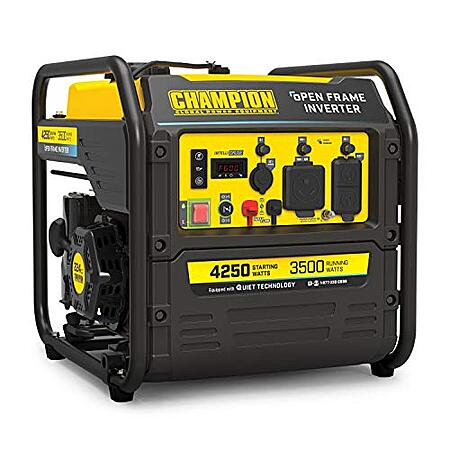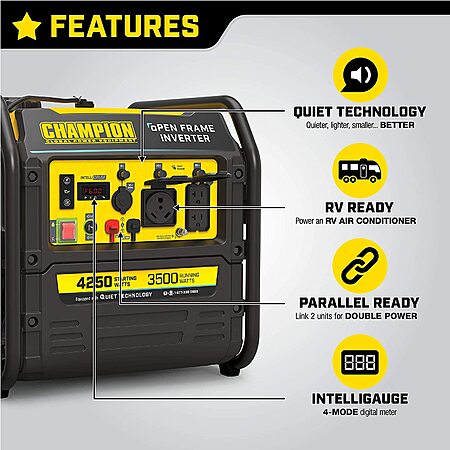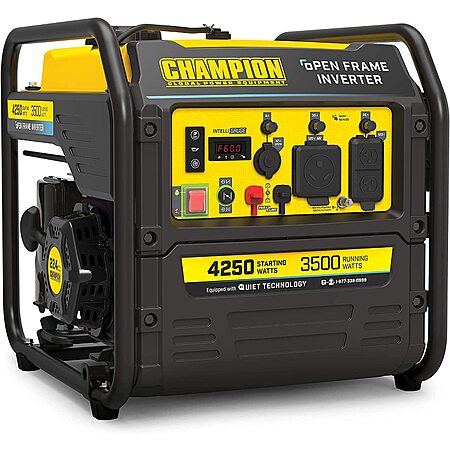Amazon has
Champion Power Equipment 4250W Open Frame Gas Inverter Generator (200954) on sale for
$419.82.
Shipping is free.
Thanks to Deal Hunter
gaamn114 for finding this deal.
Note, product must be sold/shipped by Amazon
Features (
details):
- 224cc Champion engine produces 4250 starting watts and 3500 running watts, and runs for 22 hours at 25% load when the 4-gallon fuel tank is full
- With a 0.6-quart oil capacity (included 10W-30) and a low oil shut-off sensor, this inverter operates at 64 dBA from 23 feet
- The covered outlets in this RV Ready inverter include a 120V 30A RV (TT-30R), two 120V 20A household outlets (5-20R) plus two handy 2.1A USB ports you can use to power your phone, laptop, or similar device







Leave a Comment
Top Comments
though the 200 or so more for the dual fuel model might save a lot of headaches. and you get a warranty with a small engine (which has value). what is 200 now anyways...one trip to the store?
obviously you can decide. I have done both. pros to both... but voiding a warranty can be a huge cost.
https://www.championpow
I have the Tractor Supply version of this model, it's a cost effective way to get clean power through the open inverter design and keep more sensitive electronics running in a power outage.
Happy dealhunting.
53 Comments
Sign up for a Slickdeals account to remove this ad.
That's a very good point - I was more speaking in generalities related to wiring a generator to the house. Personally, I wouldn't simply backfeed as some people do... it is far too dangerous.
But I have mine currently wired into my main panel, and previously I used a transfer switch. The transfer switch was the nicest, cleanest... but you have to identify the 6, 8 , or 10 circuits you are going to provide power to, and you can't power up anything else, without re-wiring. The nice thing about wiring it into your main panel is that you can choose, on the fly, which circuits you are going to power, and which you are going to turn off.
You can always just back feed through a dryer plug, but that's technically not legit. Granted, you're doing the *exact* same thing using the interlock kit, just the interlock kit forces you to turn off the mains in order to turn on the generator breaker. The kit is more of an idiot-proofing than anything else.
The next level is a transfer switch and subpanel - super $$ to install.
But I have mine currently wired into my main panel, and previously I used a transfer switch. The transfer switch was the nicest, cleanest... but you have to identify the 6, 8 , or 10 circuits you are going to provide power to, and you can't power up anything else, without re-wiring. The nice thing about wiring it into your main panel is that you can choose, on the fly, which circuits you are going to power, and which you are going to turn off.
This looks like a great option.
http://www.generlink.c
Haven't checked if its compatible(approved by local utilities)
Another good option
http://www.generlink.c
Some utilities will NOT allow this(including FPL in Florida)
http://www.generlink.c
Haven't checked if its compatible(approved by local utilities)
For reference, the 30A version is over $700 [homedepot.com], which is probably more than a generator of that size will cost. HD doesn't sell the 40A version, which is around $1300 [cpesupply.com]. Personally I'd tend more toward 50A; that's only ~ 12kW generator which I would consider bare minimum in portables to be a "whole home" backup solution.
A lot of this depends on how accessible the panel is - in my last house it was in the garage so SUPER accessible. This matters for materials and labor, especially if you're hiring someone - 8ga is about $1/ft, and you'll need 4 of those, so $4/ft. Heck of a difference in 20 ft vs. 150ft.. That said, even if you're not comfortable doing the actual tie-in, you can save a lot of money by doing the grunt work yourself - running conduit/wires, mounting plug boxes etc. Hate to pay someone hundreds $+ per hour just to drill holes, run tubing and pull wires. That's like paying a doctor to take vitals when a nurse can do it just as good a job.
But I have mine currently wired into my main panel, and previously I used a transfer switch. The transfer switch was the nicest, cleanest... but you have to identify the 6, 8 , or 10 circuits you are going to provide power to, and you can't power up anything else, without re-wiring. The nice thing about wiring it into your main panel is that you can choose, on the fly, which circuits you are going to power, and which you are going to turn off.
Now, it's not the case that all homes are wired this way but unless you know it's not worth the risk.
You also have to power off any 240v circuits if you do this.
Sign up for a Slickdeals account to remove this ad.
Now, it's not the case that all homes are wired this way but unless you know it's not worth the risk.
You also have to power off any 240v circuits if you do this.
Never bridge the legs in your panel.
Use an interlock vs backfeeding through a dryer/stove or garage plug , it's safer and code compliant, also error proof. I think an interlock is cheaper and easier to wire in than a transfer switch, having done both, as long as you have space in your main panel for 2 adjacent breakers. You can relocate breakers in your main panel easily to free up the specific spots you need for the interlock kit, these spots are usually closest to your main breaker.
If you don't have any shared neutrals and can identify and turn off your 240V breakers, you can use a 120V generator to backup your house. Set up your house with an L14-30P power inlet box on the outside to work with 240V generators, get an L14-30 generator cord that works with 240V generators. Get an adapter to use only with a 120V generator that will hot bridge both legs going into the generator cord.
This way, your home is wired correctly. You can use a 240V generator normally, or use a 120V generator with the adapter. Generators should be floating neutral when wired into the panel.
A couple of hot bridge adapters depending on what plug you have on your generator or parallel kit.
5-20 to L14-30 https://a.co/d/hbUhWVc
L5-30 to L14-30 https://a.co/d/alypT5Z
Leave a Comment